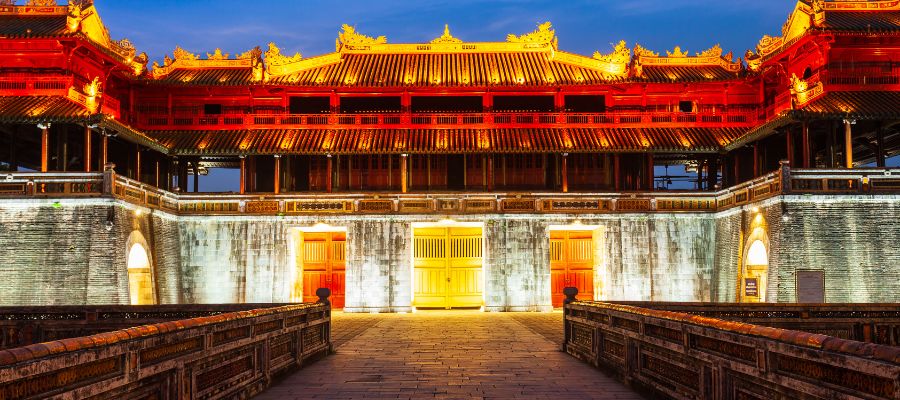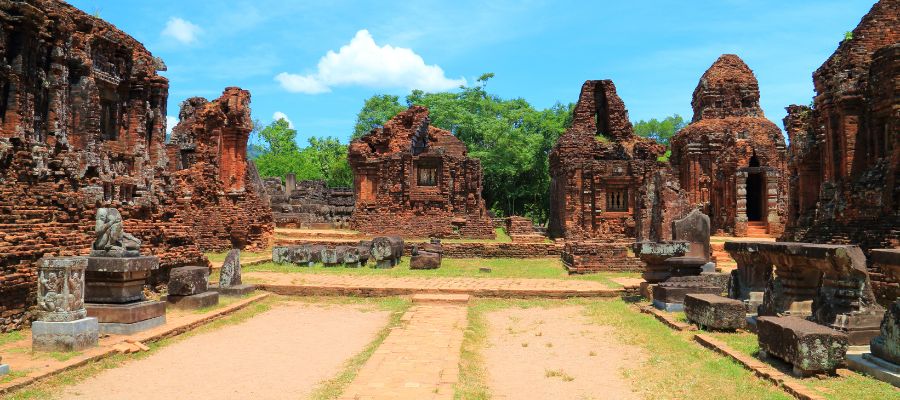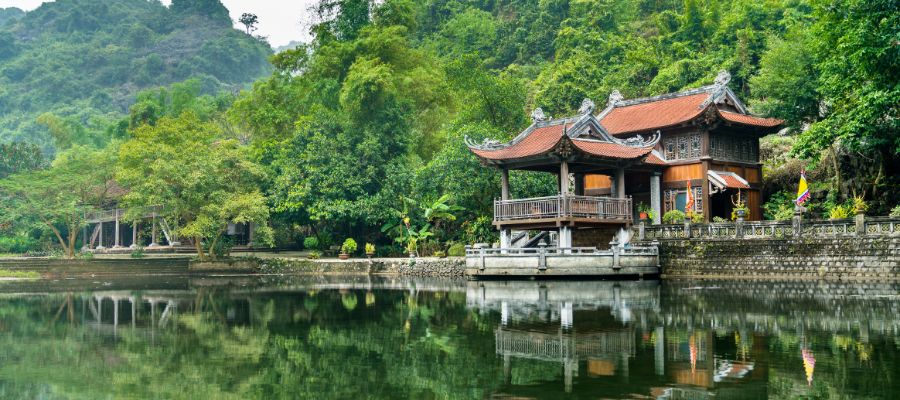A Guide to Vietnam’s UNESCO World Heritage Sites
Vietnam has 8 UNESCO World Heritage Sites, including magnificent temples, national parks, and geological wonders such as Ha Long Bay, Hoi An Ancient Town, Phong Nha-Ke Bang National Park, and My Son Sanctuary. These sites reflect Vietnam’s remarkable natural and cultural heritage and are legally protected by international treaties.

Visiting UNESCO sites allows travelers to explore lesser-known places, aid preservation, and gain knowledge about the history of Earth and humanity. There are five cultural sites, two natural sites, and one mixed site in Vietnam. From natural wonders to human engineering feats, exploring these sites can be an exciting part of your next Vietnam vacation.
UNESCO-recognized Cultural Sites in Vietnam
Vietnam boasts a rich cultural heritage that has been recognized and preserved by UNESCO. The country is home to eight UNESCO World Heritage Sites, including five cultural sites.
These sites showcase Vietnam’s unique history and architecture, from the Imperial Citadel of Thang Long in Hanoi to the ancient town of Hoi An.
Each site offers a glimpse into Vietnam’s vibrant past and serves as a testament to the country’s cultural significance on the world stage.
Thang Long Imperial Citadel – Central Sector
The Imperial Citadel of Thang Long in Hanoi, built in the 11th century, was the center of Vietnamese military power for over 1000 years.
It marked the independence of Dai Viet from its northern neighbors and remained the center of political power until the Nguyễn dynasty moved the capital south in 1802.
The Citadel was in disrepair after the French conquest of Hanoi, and only recently were its foundations excavated. It was inscribed as a UNESCO World Heritage site in 2010.
The Citadel is conveniently located in central Hanoi and offers visitors plenty of small museums, shrines, and photo spots to explore. Ongoing archeological digs and research continue to uncover new discoveries at the site.
Ho Dynasty Citadel
The Ho Dynasty Citadel was the capital of Vietnam in the 14th century, and its ruins can still be visited today, located in a scenic area between two mountain ranges and rivers.
Its construction style showcases the advancement of architectural technology in city planning, and its decorative motifs reveal the fusion of Confucian philosophy with Buddhism.
Although not as visually impressive as other UNESCO ruins, it is an exceptional example of a new construction style of southeast Asian imperial cities.
It is relatively accessible on a day trip from Ninh Binh, but it’s more suited for history buffs than those seeking Instagram-worthy ruins.
Complex of Hue Monuments
Hué is a UNESCO World Heritage Site and the former political, cultural, and religious center of Vietnam. It was the capital of unified Vietnam in 1802 and remained so until 1945.
The site was planned following ancient oriental philosophy and physical geography, with the Perfume River winding through historical monuments, and Ngu Binh Mountain providing a ‘Royal Screen’ to the site.
During the Vietnam War, U.S. troops were commanded not to bomb or shell the city, but considerable damage was still inflicted. Today, many buildings have been restored and repaired, making the grounds of the Imperial City one of Vietnam’s top attractions.
Hoi An Ancient Town
Hoi An is a well-preserved trading port from the 15th century and an amalgamation of indigenous and foreign cultures, making it one of the most well-known cultural sites in Vietnam.
Its historical prominence as a trade channel between Europe, China, India, and Japan is still visible today through traditional architecture, heritage, and textiles.
Despite being a little over-touristy, it remains unique and beautiful. Visitors can also explore the food scene, beaches, and nightlife outside of the old town.
My Son Sanctuary
My Son Sanctuary in central Vietnam is a UNESCO world heritage site showcasing the ruins of the Hindu Champa civilization. The site is comparable to other temple complexes in Southeast Asia, such as Borobudur and Angkor Wat.

The ruins were largely forgotten and suffered damage during the American War, but have survived remarkably intact. Today, mass tourism is taking its toll, so it’s best to visit in the afternoon or on a less busy half-day morning tour.
Despite the crowds, My Son Sanctuary is an extraordinary architectural ensemble with a rich history.
UNESCO-recognized Natural Sites in Vietnam
Vietnam is home to several stunning natural sites that have been recognized and protected by UNESCO. From the towering limestone cliffs and emerald waters of Ha Long Bay to the unique biodiversity of Phong Nha-Ke Bang National Park, these natural wonders offer visitors a glimpse into Vietnam’s awe-inspiring landscapes.
The country’s four UNESCO natural sites showcase the diversity of Vietnam’s ecosystems, from coastal mangroves to mountainous forests. These sites are not only important for their ecological significance but also for their cultural and recreational value.
Ha Long Bay
Ha Long Bay in Vietnam is a UNESCO World Heritage Site with over 1,600 limestone islands and islets, offering a dramatic seascape.
Despite being historically uninhabited, the site is suffering from over-tourism and deteriorating water quality. Longer cruises that explore the less busy routes are recommended to fully appreciate the beauty of the site.
While Ha Long Bay is a must-see in Vietnam, it’s important to be mindful of its ecological and cultural significance and to choose sustainable tourism practices.
Phong Nha-Ke Bang National Park
The Phong Nha-Ke Bang National Park in north-central Vietnam is a UNESCO world heritage site renowned for its limestone karst mountains, tropical forests, and extensive cave network.
It boasts the world’s largest cave, the Son Doong Cave, and a rich biodiversity of flora and fauna. Despite booming tourism, only a fraction of the park is open to tourists due to unexploded ordnance from the Vietnam War.
The site is constantly revealing new natural wonders and is a must-see destination for nature lovers.
UNESCO-recognized Mixed Sites in Vietnam
Vietnam is home to several UNESCO world heritage sites that blend cultural and natural heritage. One such site is the Trang An Landscape Complex, situated in northern Vietnam.
This mixed site includes a spectacular landscape of karst peaks and valleys, along with the Hoa Lu Ancient Capital, a former political and cultural center of Vietnam.
The Trang An Landscape Complex is a testament to the unique relationship between humans and nature in this region, making it a must-visit destination for cultural and nature enthusiasts alike.
Trang An Landscape Complex
Trang An Landscape Complex in Vietnam is a UNESCO World Heritage Site known for its limestone karst peaks, deep valleys, and meandering rivers.

It is also a mixed site, containing archaeological evidence of human activity dating back more than 30,000 years.
The property can be explored by boat, taking in temples, pagodas, and paddy fields, but is suffering from overtourism. To avoid the crowds, visitors should consider staying in nearby Ninh Binh and taking a longer boat tour later in the day.
Maintaining Communication while Traveling
Maintaining Communication while Traveling can be crucial, so here are some tips in bullet points and sorted by category:
Before Traveling:
- Choose the right communication tools for your needs (e.g., phone, messaging app, email, video chat)
- Check your mobile phone coverage and consider buying a local SIM card or an international roaming plan
- Set up a VPN for secure internet access
- Share your itinerary with family and friends
- Keep important contact information in a secure and accessible location (e.g., emergency contacts, embassy information)
During Traveling:
- Turn on your phone’s roaming or international data plan
- Use public Wi-Fi networks cautiously and only connect to trusted networks with password protection
- Keep your phone charged and bring a portable power bank or charger
- Adjust your phone’s settings to reduce data usage (e.g., disable automatic updates, limit background data usage)
- Use messaging apps to communicate with family and friends (e.g., WhatsApp, Facebook Messenger, iMessage)
- Consider using a video chat app to make free or low-cost calls (e.g., Skype, Zoom, FaceTime)
In case of Emergency:
- Register with your embassy or consulate
- Keep your phone charged and easily accessible
- Have a backup plan for communication in case of lost or stolen phone
- Consider purchasing travel insurance that includes emergency medical and evacuation coverage
Remember to prioritize your safety and follow local laws and customs when communicating while traveling.
Important Considerations Before Embarking on Any Adventure
Embarking on an adventure can be exciting, but it’s important to plan and prepare beforehand. Here are some important considerations to keep in mind before you set out, sorted by category:
Health and Safety:
- Research potential health risks and required vaccinations for your destination
- Get a medical check-up and consult your doctor about any necessary medication or precautions
- Purchase travel insurance that covers medical emergencies, evacuation, and trip cancellation
- Learn about the local laws and customs and follow them accordingly
- Carry a basic first-aid kit with essential supplies
Logistics:
- Plan your itinerary and transportation arrangements ahead of time
- Check visa requirements and apply for necessary visas in advance
- Secure necessary permits and licenses for adventure activities (e.g., trekking, diving, wildlife safaris)
- Make copies of important travel documents (e.g., passport, insurance, tickets) and keep them in a safe and secure location
- Consider packing light and bringing versatile, comfortable clothing and gear
Finances:
- Set a budget for your trip and research the costs of travel, accommodation, food, and activities
- Consider exchanging some cash or getting a travel card for easy access to local currency
- Keep track of your expenses and carry a backup credit card or emergency cash
- Research the local tipping customs to avoid social faux pas
Communication:
- Share your itinerary with family and friends and keep them updated on your whereabouts
- Research communication options at your destination (e.g., mobile phone coverage, internet access, messaging apps)
- Consider bringing a portable charger or power bank for your devices
- Have a backup plan in case of lost or stolen phone or communication breakdowns
Remember to be flexible and adaptable during your adventure, and always prioritize your safety and well-being.
91 responses to “A Guide to Vietnam’s UNESCO World Heritage Sites”
Recent Posts
Other Info
- Turkey Visas for Tourism, Business Purposes
- Apply for Turkish Student Visa
- Turkey Work Visa or Work Permit
- Turkey Transit Visa
- Turkey Residence Permit
- Turkish Visa
- E Visa of Turkey
- Visa for Turkey US Citizen
- Turkey Visa for Pakistani
- Electronic Visa Turkey
- Turkey Travel Visa
- Visa on Arrival Turkey
- US Citizen Travel to Turkey
- Chinese Embassy Turkey
- Visa for Turkey From Canada
- Visa Required for Turkey
- Visa Transit Turkey
- Turkey Transit Visa for US Citizens
- Form for Entry to Turkey
- Turkey Visa for US
- Visa Requirements for Turkish Citizens
- Need Urgent Turkey Visa?
- Turkey Visa Information
- Turkey Essential Guidelines for U.S. Citizens
- US Visa for Turkey
- Passport for Turkey
- Turkey Visa Online
- Turkey Visa for Indian
- Turkish Visit Visa
- Visa Application Form Turkey
- E Visa Turkey Cost
- Tourist Visa to Turkey
- Visa Application to Turkey
- Apply Visa to Turkey
- Traveling to Turkey From Canada
- Getting a Visa for Turkey
- Visa Cost Turkey
- Kenya E Visa
- eVisa Kenya Online
- Kenya Online Visa
- Kenya e-Visa
- Kenya Entry Requirements
- Kenya Visa Requirements for US Citizens
- Kenya Visa for US Citizens
- Vaccines For Kenya
- Yellow Fever Vaccine Kenya
- Yellow Fever Certificate Kenya
- Vaccinations Required For Kenya
- Kenya Transit Visa
- Kenya Multiple Entry Visa
- Kenya Business Visa
- Kenya E Visa Fees
- Kenya eVisa Cost
- Kenya evisa Application
- Kenya Online Visa Application
- Kenya evisa Processing Time
- Kenya Visa on Arrival
To start applying online click on 'Apply Now' Button
kinohd
кинконг
I appreciate you sharing this blog article.Much thanks again. Will read on…
Very informative article.Really looking forward to read more. Cool.
I think this is a real great blog article.Thanks Again. Awesome.
Thanks for the article post.Really looking forward to read more. Fantastic.
Thank you for your article post.Thanks Again. Great.
I am so grateful for your article post.Really looking forward to read more.
Very good blog article.Really thank you! Fantastic.
Awesome article post. Want more.
Major thanks for the post.Thanks Again. Much obliged.
I think this is a real great blog.Really looking forward to read more. Great.
Muchos Gracias for your article post.Really looking forward to read more.
wow, awesome blog post.Really thank you! Cool.
Major thankies for the blog article. Keep writing.
Great, thanks for sharing this blog article.Much thanks again. Really Great.
Very neat blog post. Great.
Appreciate you sharing, great article post.Really thank you!
порно онлайн
A round of applause for your article post. Really Great.
Enjoyed every bit of your blog article.Really thank you!
I appreciate you sharing this blog.Thanks Again. Really Great.
Wow, great article post.Much thanks again. Cool.
Im obliged for the blog article.Much thanks again.
Very informative post.Thanks Again. Great.
I truly appreciate this blog post.Really looking forward to read more. Keep writing.
Awesome blog post.Really looking forward to read more. Much obliged.
I think this is a real great article post. Keep writing.
Thank you ever so for you article. Great.
Thanks-a-mundo for the post.Much thanks again. Great.
I value the article post.Much thanks again.
Really informative blog.Really looking forward to read more. Cool.
I really liked your article.Really thank you! Fantastic.
Very neat post.Much thanks again. Will read on…
Thank you for your article post.Much thanks again. Keep writing.
I cannot thank you enough for the blog article. Really Cool.
Thanks-a-mundo for the blog.Really thank you! Awesome.
I cannot thank you enough for the article.Thanks Again. Keep writing.
Im grateful for the blog article.Really thank you! Really Cool.
This is one awesome blog post.Thanks Again. Fantastic.
Awesome article.Much thanks again. Want more.
Wow, great post.
I value the article. Want more.
Im obliged for the article. Awesome.
Major thankies for the blog. Great.
Im obliged for the article post.
I cannot thank you enough for the blog article.Much thanks again. Keep writing.
wow, awesome article.Really thank you! Want more.
Im thankful for the blog article.Really thank you! Really Great.
I value the blog article.Really looking forward to read more. Much obliged.
Really informative article.Really thank you! Really Great.
Thank you for your article post.Really thank you! Really Cool.
I really enjoy the post.Much thanks again.
I really like and appreciate your article.Really thank you! Much obliged.
Great, thanks for sharing this blog.Really thank you! Much obliged.
Very neat blog article.Thanks Again. Great.
Great, thanks for sharing this blog article.Thanks Again. Fantastic.
Hey, thanks for the post.Really looking forward to read more. Want more.
Great blog article.Really thank you! Keep writing.
Major thanks for the article post.Thanks Again. Great.
Major thankies for the blog article.Really thank you! Great.
Thanks a lot for the blog article.Really looking forward to read more. Awesome.
Thanks-a-mundo for the blog post.Really thank you! Awesome.
Thanks a lot for the post.Really looking forward to read more. Really Cool.
I think this is a real great article.Really looking forward to read more. Much obliged.
I think this is a real great blog article. Fantastic.
Major thanks for the article.Much thanks again. Fantastic.
Thanks again for the article.Really looking forward to read more. Much obliged.
A big thank you for your article.
Thanks a lot for the article. Will read on…
Thanks-a-mundo for the post.Much thanks again. Will read on…
Thanks for sharing, this is a fantastic blog post.Thanks Again. Want more.
Thanks-a-mundo for the article post.Really thank you! Really Great.
Thanks again for the blog post.Thanks Again. Really Great.
Im grateful for the article. Really Great.
Looking forward to reading more. Great blog article.Really thank you! Great.
Im grateful for the article post.Really thank you! Keep writing.
Thanks-a-mundo for the blog post.Really thank you! Awesome.
Major thanks for the blog post.Really looking forward to read more. Cool.
I appreciate you sharing this article post. Really Cool.
Looking forward to reading more. Great blog.Much thanks again. Much obliged.
Thank you for your blog. Want more.
Great blog article.Really looking forward to read more. Great.
Great, thanks for sharing this blog post.Really looking forward to read more. Really Cool.
Thanks so much for the article.Much thanks again. Really Great.
Im grateful for the blog post.Really thank you! Keep writing.
I think this is a real great article.Much thanks again. Really Cool.
Im obliged for the blog. Cool.
Thanks for the blog article. Want more.
Very good article. Great.
Really enjoyed this blog article.Thanks Again. Great.